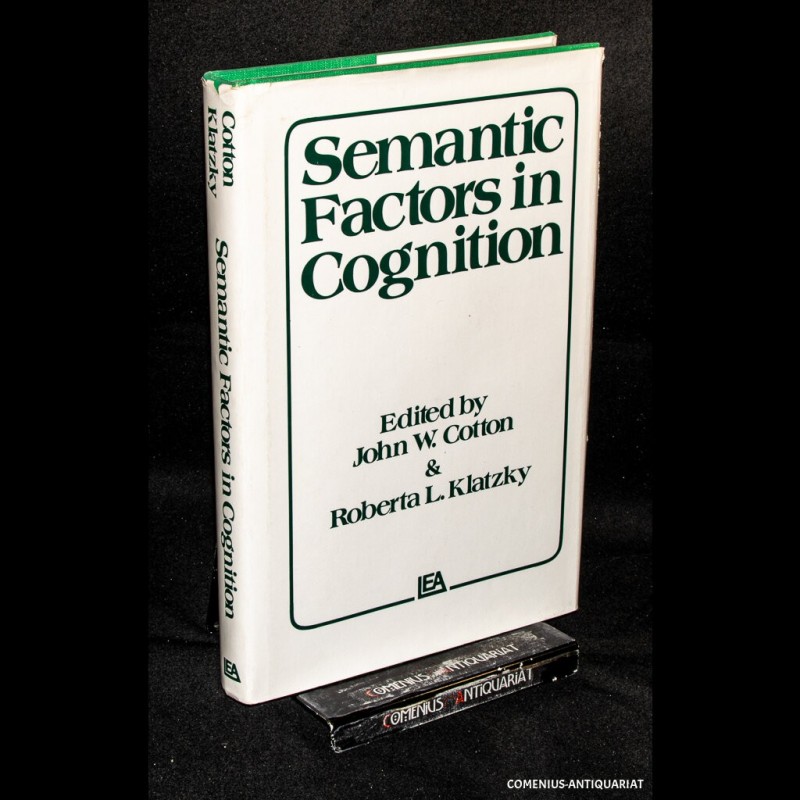Cotton, John W. und R.L. Klatzky [ed.],
Semantic Factors in Cognition. Hillsdale: Lawrence Erlbaum Associates, Inc., 1978. xii, 239 Seiten mit Register. Leinen mit Schutzumschlag. Grossoktav. 235 x 160 mm. 498 g
* Papers presented at a conference held on May 26 and 27, 1976 at the University of California, Santa Barbara. Includes bibliographical references. . - Schutzumschlag mit Gebrauchsspuren.
Bestell-Nr.158441 | ISBN: 0-470-99340-5
Cotton Klatzky |
Psychologie |
Psychology
SEMANTIC FACTORS IN COGNITION
edited by JOHN W. COTTON and ROBERTA L. KLATZKY
This volume is based on a conference held at the University of California, Santa Barbara. It contains six original papers that describe theoretical and experimental analyses of the role of semantic data in cognitive processes. These papers are accompanied by six critical discussions. The first two chapters present theories of the role of imagery in thinking and the learning process, respectively. The remaining four major chapters have a more empirical tone; data are presented relating semantic factors to such diverse areas as pic-ture categorization and the use of the lin-guistic operator IF. The six chapters of dis-cussion serve an integrative function, calling for a metatheory to combine the views of the featured chapters. Here are new data, new theory, and new integrations by outstanding figures in cog-nitive psychology. This work will be of ut-most interest to researchers and scholars in psychology, linguistics, computer science, and artificial intelligence.
Contents
Preface ix
SECTION I
1. Imageful Thought
Ear/ Hunt 3
Structural Assumptions 5
Functional Relations 10
Evaluation and Extension 19
Principles and Concepts 28
Concluding Remarks 32
References 33
2. Accretion, Tuning, and Restructuring: Three Modes of Learning
David E. Rume/hart and Donald A. Norman 37
Learning and the Acquisition Of Knowledge 38
Memory Schemata 40
Learning 44
Learning Is Not a Unitary Process 50
References 52
3. Comments on the Papers by Hunt and by Rumelhart and Norman
Douglas L. Hintzman 55
References 60
4. A Seductive Paradigm
Howard H. Kend/er 61
References 67
SECTION 11
5. Semantic Information and Visual Information Processing
Roberta L. Klatzky and Ann M. Stoy 71
Review of Literature 72
Research of Klatzky and Stoy 80
References 100
6. Some Factors Involved in the Recognition of Words
Carol Conrad 103
Isolable Subsystems in Semantic Memory 103
Spreading Activation 108
The Role of Attention in Word Recognition 111
Summary 118
References 119
7. Processes in Classifying Pictures and Words: Parallel?
Independent? Obligatory?
Janice M. Keenan. 121
References 128
8. The Distributed Memory Model Revisited:
Discussion of the Papers by Conrad and by Klatzky and Stoy
Russe// Rev/in 129
References 133
SECTION Ill
9. Nominal, Perceptual, and Semantic Codes in
Picture Categorization
Edward E. Smith, Gerald J. Balzano, and Janet Walker 137
Introduction 137
Experiment 1: Picture-Word Categorizations
143
Experiment 2: Naming Items 155
A Parallel Model for Picture-Word Categorization
158
Open Questions and Future Directions 164
References 167
10. How to do Some Things With IF
Samuel Fillenbaum
169
Some Uses of the Operator IF 171
Uses to Which Operators May Be Put 185
Where Things Stand 209
References 213
11. Comments on Lexical Semantics
Allen Munro 215
The Representation Code: Form and Access 217
Meanings in Context 218
References 221
12. Comments on the Papers by Smith, Balzano,
and Walker, and by Fillenbaum
Kenneth Wexler 223
References 231
Author Index 233
Subject Index 237






 Datenschutz
Datenschutz
 Versandkosten
Versandkosten
 Google Mail
Google Mail
